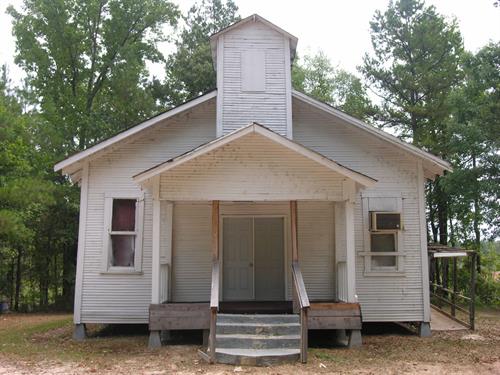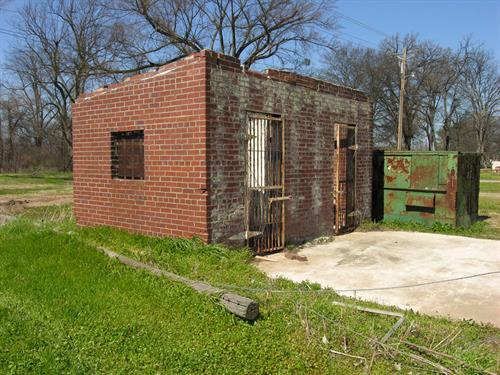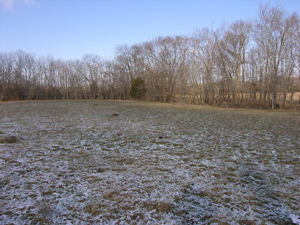Listed in Arkansas Register of Historic Places on 04/04/07
SUMMARY
The Crash Site AC 41-7441 is being nominated to the Arkansas Register of Historic Places with local significance under Criterion A for its significance as the only World War II aviation crash site in central Arkansas and for its association with World War II aviation and home front activities. The site is also being nominated under Criterion D for its potential to yield important information about the B-26A aircraft used during World War II.
ELABORATION
On September 2, 1942 at 11:15 pm, a B-26A bomber crashed near Pinnacle Mountain, seven miles northwest of Little Rock, Pulaski County, Arkansas. The six U.S. Army airmen aboard the plane took off at Barksdale, Louisiana on a cross-country routine flight. They were not scheduled to land in Adams Field, the main air field in Little Rock, Arkansas. The exact circumstances of the crash are unknown. However, a student under the direction of a Civilian Instructor at Adams field reported a radio message from an unidentified plane that was circling Adams Field and returning to Barksdale, Louisiana. Witnesses of the crash, claim that the pilot was traveling north along the Arkansas River before turning southwest. The B-26A aircraft crashed in a narrow strip of woods, ¼ mile long near Pinnacle Mountain. The debris of the crash was scattered fifty yards wide and three hundred and fifty yards long over the site. The crash resulted in fatalities of all the men aboard the plane. These men that died in the crash were pilot Kenneth Reddy, 1st Lt., and co-pilot in the Doolittle Raid in Japan, Charles S . Brachbill 2nd Lt., Phillip Williams, 2nd Lt., Thomas T. Roberts Sgt., Dominic T. Moduno, Col., and Thomas A. Naylon, Pvt.
The crash received nationwide attention. Edward Arnold and Frances Dee, celebrities, were introduced to Lt. Reddy at a war savings bond rally the week before his crash. After hearing the news, Arnold commented “such accidents bring the war closer home and should make Americans realize the great adventure our boys in service are facing.” Rallying citizen support he continued “civilians should feel ashamed unless they are doing their part to win the war and taking part in an effort to limit similar tragedies.” The crash had quite an impact on bringing together the World War II effort on the home front.
The pilot of the crash, Kenneth Reddy was an average student and not very athletic, but he had an exceptional aptitude for flying as Jimmy Doolittle and Ross Greening would comment later in their books Not as Briefed and I Could Never Be So Lucky Again. Ken attended a high school that was steep in athletic tradition but he was the editor of the school newspaper.
After graduation from University of North Texas, Kenneth wanted to earn enough money to repay his school loans and make enough to complete his master’s degree. The country was still recovering from the Depression and jobs were scarce. A friend recommend Ken consider a hitch in the Army. After some research, Ken learned that an Air Corp pilot would earn more than the regular Army officer. However, in 1940 (prior to WWII), becoming an Army pilot was almost impossible as the number of applicants was three time the number of open positions. Moreover, only the top applicants were selected for training and twenty percent of them would wash-out. Ken figured it was worth a try and to his surprise he graduated at the top of his class and earned his wings in June 1941.
After the Doolittle raid, Ken was an instant national hero. His college (University of North Texas) forgave all his debt and he was assured he could finish his masters after the war at no cost to him. He was also honored by the mayor at a town meeting after speaking at the University in June 1942. Ken toured the country during the summer of 1942 speaking to civic organizations and town assemblies. However, he always insisted that “he was not a hero that he had only done his job.” Further, he would say “the real heroes were the boys that didn’t come home and we must honor them by never forgetting them or what they have done for us.”
Kenneth Reddy’s contributions to the Doolittle raid extended far beyond normal copilot duties, the flying of a B26 was a two man job as both pilot and copilot had continuous duties to keep the plane flying at optimum efficiencies. This was especially true on this mission as they lacked enough fuel to make it to China. Ken continually monitored and modified the manifold pressure and prop pitch to ensure maximum gas mileage helping to ensure they made landfall.
He along with Capt. Greening developed the “Tom Sawyer” bomb site thus allowing the top secret Norton bomb site to be removed from all 16 B-25s. This allowed pilots to bomb their targets very accurately and should they be shot down, the top secret Norton bomb site would not fall into the hands of the enemy. He and Greening also recommended the now famous painted broom handles to reduce weight and discourage attack from the rear of the plane by the enemy. Plane #11 shot down two enemy planes and damaged a third.
They were the only plane to actually shoot down enemy planes during the raid. From his copilot’s seat, Kenneth spotted and directed fire. Sgt. Gardner, from Kenneth’s instructions, spotted and downed the two planes.
Kenneth was the co-pilot of plane number 11 from the famous Doolittle raid on Japan. He was one of 80 courageous men who flew B-25 bombers off the deck of the aircraft carrier, the Hornet. Flying bombers off the deck of a carrier had never been done before. However, on the morning of April 18, 1942, 80 young men did. They left the deck of the carrier 400 miles and 10 hours earlier than scheduled. Without the fuel needed to reach airfields in China and without homing devices to guide them, they flew off to Japan and what must have seemed to be certain death. They would be dropping their bombs at midday instead of midnight as planned. The plane carrying homing signals to the designated airfields in China had crashed en route and Admiral Bull Halsey had forgotten to notify the Chinese army that the boys were on their way. The only thing waiting for these boys would be Japanese aircraft, antiaircraft guns and a raging rain storm off the cost of China.
In April of 1942, the United States was sixteenth in world military power and was fighting against the most powerful country in the world. Most of the world thought that we would surely lose. Most of the world thought as our enemies such as Herman Goering, that America “was a country of playboys who paid other to do their fighting,” “American boys lacked the courage for war” and “America was only proficient at manufacturing razor blades.” However, eighty brave young men sent a message to the world and especially to Japan that day. The message was clear; America did not lack courage, ingenuity or cunning and was willing to pay the ultimate price for complete victory. This single event changed the course of the war. The raid lifted the spirits of an entire nation and gave a world clouded by the threat of tyranny and oppression a bright ray of hope.
Though the physical damage caused by the raid was limited, its overall impact on World War II was dramatic. America and her allies in April 1942 had not won a battle in the war thus far. Singapore, Hong Kong, much of China, Burma and the Philippines had all been taken and thousands of American boys were dead, captured or dying on the Bataan death march. There had never been nor has there since been one single event that so dramatically changed the course of history.
Kenneth Reddy and 79 other fearless men did what no one thought could be done. They drove a spear deep into the heart of the Rising Sun and more importantly they gave America the courage to believe that the war could be won and that our boys could win it. Our country was transformed in April 1942 from a defeated, doubting mass to a spirited, confident, and determined America. President Roosevelt said in 1943 that “they (the Doolittle Raiders) were the men who changed the course of the war in the Pacific.”
Jimmy Doolittle was awarded the Congressional Medal of Honor (the highest award given by our country) which he received on behalf of all 80 members of the raid. The presentation was made by President Roosevelt in the oval office. Kenneth was also the recipient of the Distinguished Flying Cross and received the Chinese equivalent of the Medal of Honor from Madam Chiang Kai-shek.
After the raid, the Japanese advance was halted. The Japanese pulled troops and ships back to Japan to defend the home islands, which led to America’s victory at Midway, and ultimately victory over Japan. It has been said many times that, “before the Doolittle raid, America and her allies had only known defeat, but after the raid, America and her allies only new victory.”
The following are comments about the raid are by award winning historian and author Craig Nelson.
"Immediately after this historic declaration of war, Franklin Delano Roosevelt called Army Chief of Staff George C. Marshall, Army Air Force Chief
of Staff Henry Arnold, and Chief of Naval Operations Ernest King to a meeting at the White House. What the President wanted, straight away, was a retaliatory
strike against the Japanese - a bombing of Tokyo itself. American military power at the time, however, was nowhere near the force of Japan’s, and to
the chiefs, a raid on the home islands was just inconceivable. The Army didn’t have airfields close enough to use land-based bombers, and the Navy
couldn’t get carriers near enough to the islands to launch their fighters before being detected and attacked. Roosevelt insisted it must happen - for
the sake of the United States and for the sake of the entire Allied cause, there had to be a stirring victory, now - and he hounded the chiefs
with this demand week after week.
"The mission will become America’s first great World War II victory. It will deliver a crushing blow to Japan, a shock that will directly lead to the
extraordinary triumph of Midway. It will be a major turning point for Britain and the U.S., the start of our winning the War, and in fact the start
of the world believes that the Allied Powers might triumph. Originally considered a suicide mission, 90% of its men will come home alive, famous around
the world.
"News of the Tokyo Raid spread rapidly across the country through radio and the tabloids. When asked where the bombers had launched, FDR, not wanting
to reveal the Army-planes-on-a-Navy-carrier strategy, said 'from our new base in Shangri-La.' This made the whole story even more romantic, exciting
and mysterious. It was the first time in many years that America had something to be really proud of, it was the first big American victory of World
War II, and many remember to this day the moment they heard that ‘our boys’ had successfully attacked Japan - especially the many Americans who had
feared the Allied cause was doomed. Doolittle and his astounding victory gave the nation a new reason to hope."
B-26 HistoryBefore the United States declared war on Japan, the U.S. government supported the Allied Powers by sending equipment and military troops
to assist in the war in Europe. At this time, U.S. advances in technology, especially those in aircraft, were flourishing as a result of the increased
war efforts. In 1939, the Glenn L. Martin Company introduced a new design for a twin engine medium bomber to the U.S. Army Air Corps. This design,
the Martin Model 179, was put on the production line even before it was tested because of the urgent need for this type of aircraft in World War II.
In 1940, tests on this aircraft provided the U.S. Army Air Corps with the necessary faith in the product to continue its production. By 1942, this aircraft gained popularity and its common name, the B-26.
Despite its speed and high performance, the B-26 had a few faults, which resulted in the end of its production in November 1942. Because of its small wing area, and resulting high wing loading, the B-26 had a very high-speed landing. In addition, the electric pitch change mechanism in its engine, the R-2800, would fail without proper maintenance. This mechanism controlled the pitch of the propellers blades, and they would go flat and result in a loss of power if the mechanism was not working properly. Similarly the placement of the engines outboard would cause the aircraft to flip on its back if there was loss of power on one side. These problems with the engine often resulted in accidents during take-off, so the aircraft became commonly referred to as the “Widowmaker” and other nicknames of the same kind.
In November 1942, a Commission of Inquiry headed by Senator Harry Truman was sent to investigate the problem after two B-26 Marauders crashed at Avon Park Bombing Range. These crashes in addition to the numerous crashes of these planes during training at MacDill Field led the committee to the decision to put an end to B-26 production.
Given the problems with the B-26, an improved model of this plane was designed with more safety. This aircraft, the B-26B had an increase in wingspan and the lowest attrition rate of any aircraft in war. However, it had a reduced speed and did not gain the same amount of popularity as the former B-26 model.
In the Southwest Pacific theatre B-26 squadrons under primitive conditions attacked Japanese bases from air fields in New Guinea and Fiji. The B-26 flew in support of naval vessels during the Battle of Midway. B-26 Marauders provided effective ground support to Allied forces in Corsica, Italy, Sardinia, Sicily and Southern France. B-26s supported the landing at Anzio, Italy, and other key actions both in Italy and North Africa saving hundreds of lives on the ground. Marauders were a key element of the invasion of Europe on D-Day as squadrons of the 9th air force bombed both Utah and Omaha beaches under limited visibility at low altitude. B-26 bombing of Utah and Omaha beaches prior to the landing of troop significantly reduced casualties. In northern Europe B-26s provided invaluable support to ground troops and neutralized enemy airfields, roads, bridges, railroads and the dreaded V-1 guided bomb sites. As a medium bomber the B-26 was unsurpassed by any other medium bomber of the period once initial design flaws were corrected.
Further research on the site could yield important information about the B-26A aircraft. The information from this site could answer questions about this World War II aircraft construction, its technology and use. This information could help answer broader questions about the models and types of aircraft used during World War II. In addition, this site could answer questions about the circumstances of the crash because the exact causes are unknown. This information may be useful in researching the safety and assurance of military aircraft today. Finally, the crash could lead to information on the significance of the pilots, Kenneth Reddy (co-pilot of the Doolittle Raid) and the five other men. This research would contribute to United States aviation and military history.
SIGNIFICANCE
The Crash Site AC 41-7441 is being nominated to the Arkansas Register of Historic Places with local significance under Criterion A for its significance
as the only World War II aviation crash site in central Arkansas and for its association with World War II aviation and home front activities. The
site is also being nominated under Criterion D for its potential to yield important information about the B-26A aircraft used during World War II.
BIBLIOGRAPHY
Nelson, Craig. The First Heroes.
Greening, C. Ross. Not As Briefed.
Glines, Carroll. The Doolittle Raid.
Doolittle, James. I Could Never Be So Lucky Again.
http://en.wikipedia.org/wiki/B-26_Marauder
Diary of Lt. Kenneth E. Reddy (www.northtexasvets.com)
Personal interview with Lt. Reddy’s cousin: Edna Lindsey
“Parts Salvaged from Wreckage of B-26 Bomber.” Arkansas Democrat. September 4, 1942.
“Six U.S. Fliers Dead in Plane Crash Here. Arkansas Democrat. September 3, 1942.



